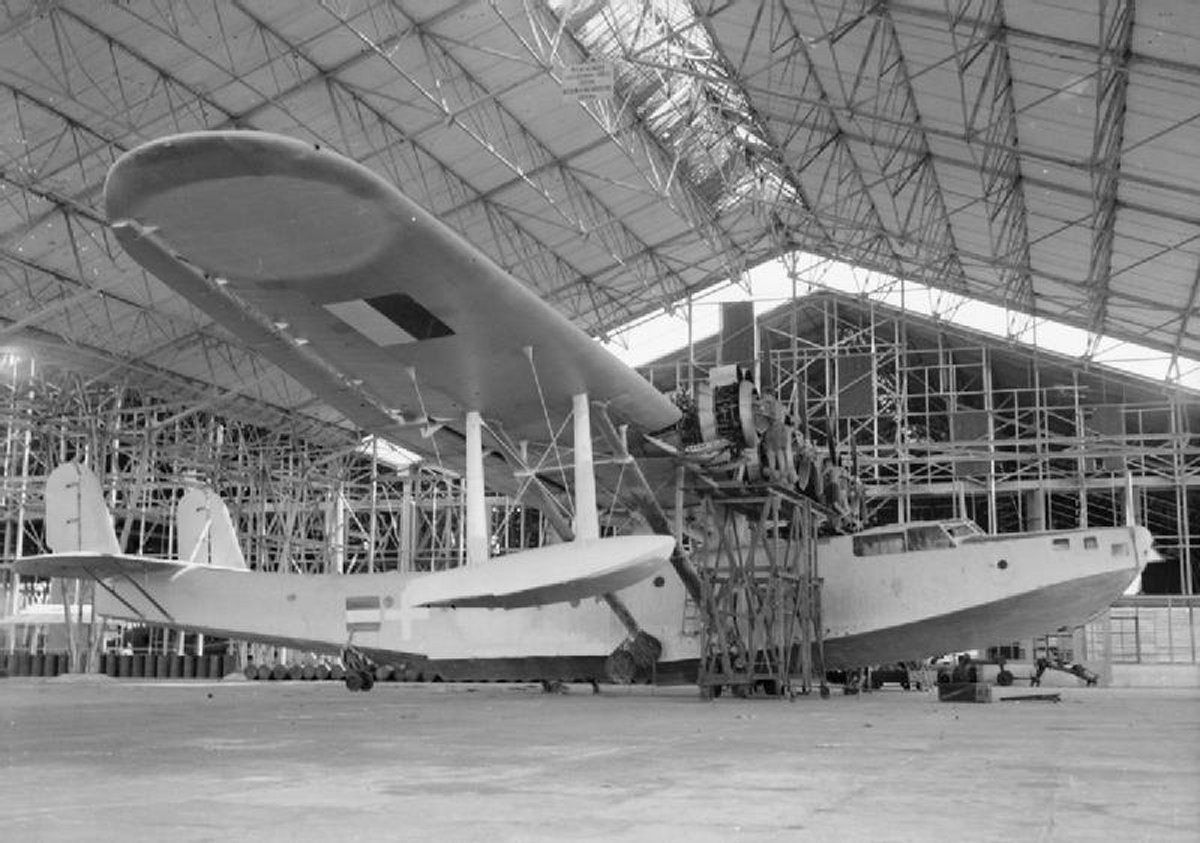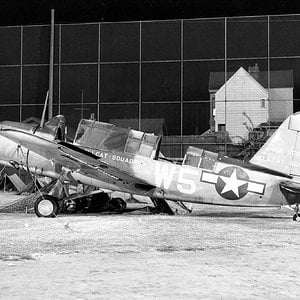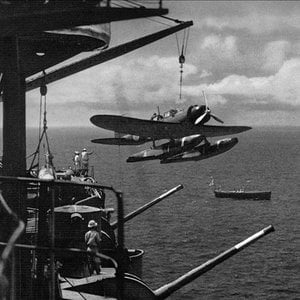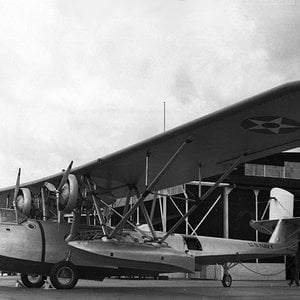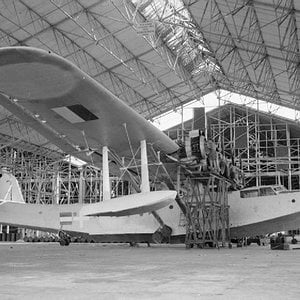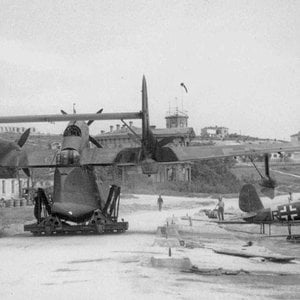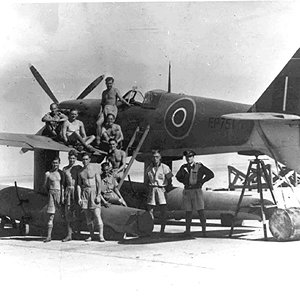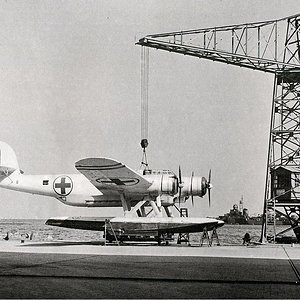Navigation
Install the app
How to install the app on iOS
Follow along with the video below to see how to install our site as a web app on your home screen.
Note: This feature may not be available in some browsers.
More options
You are using an out of date browser. It may not display this or other websites correctly.
You should upgrade or use an alternative browser.
You should upgrade or use an alternative browser.
Kawanishi H6K Mavis
Mechanics of 3219 Servicing Command of Royal Air Force (RAF), check the engines of a Japanese Kawanishi H6K 'Mavis' flying boat at Sourabaya Java, in preparation for an air test flight. Of interest are the markings added by Indonesian nationalists and the fact that an additional band of blue has been added to the fuselage marking by the Dutch.
Date January 1946.
The Kawanishi H6K was an Imperial Japanese Navy flying boat produced by the Kawanishi Aircraft Company and used during World War II for maritime patrol duties. The Allied reporting name for the type was Mavis; the Navy designation was "Type 97 Large Flying Boat, The aircraft was designed in response to a Navy requirement of 1934 for a long range flying boat and incorporated knowledge gleaned by a Kawanishi team that had visited the Short Brothers factory in the UK, at that time one of the world's leading producers of flying boats, and from building the Kawanishi H3K, a license-built, enlarged version of the Short Rangoon. The Type S, as Kawanishi called it, was a large, four-engine monoplane with twin tails, and a hull suspended beneath the parasol wing by a network of struts. Three prototypes were constructed, each one making gradual refinements to the machine's handling both in the water and in the air, and finally fitting more powerful engines. The first of these flew on 14 July 1936 and was originally designated Navy Type 97 Flying Boat, later H6K. Eventually, 217 would be built , Operational history H6Ks were deployed from 1938 onwards, first seeing service in the Sino-Japanese War and were in widespread use by the time the Pacific War full-scale erupted, in 1942. At that time of the war, four kokutai operated a total of 66 H6K4s.
The type had some success over South East Asia and the South West Pacific. H6Ks had excellent endurance, being able to undertake 24-hour patrols, and was often used for long-range reconnaissance and bombing missions. From bases in the Dutch East Indies, they were able to undertake missions over a large portion of Australia.
However, the H6K became vulnerable to a newer generation of heavier armed and faster fighters. It continued in service throughout the war, in areas where the risk of interception was low. In front-line service, it was replaced by the Kawanishi H8K.
Variants
A H6K2-L Navy Transport Flying Boat Type 97H6K1
Evaluation prototypes with four Nakajima Hikari 2 engines, 4 built.
H6K1 (Navy Flying Boat Type 97 Model 1)
Prototypes with 746 kW 1,000 hp Mitsubishi Kinsei 43 Engines, 3 converted from the original H6K1 prototypes.
H6K2 Model 11
First production model. Includes two H6K2-L officer transport modification, 10 built.
H6K2-L (Navy Transport Flying Boat Type 97)
Unarmed transport version of H6K2 powered by Mitsubishi Kinsei 43 engines, 16 built.
H6K3 Model 21
Modified transport version of H6K2 for VIPs and high-ranking officers, 2 built.
H6K4 Model 22
Major production version, modified H6K2 with revised weapons, some with 694 kW (930 hp) Mitsubishi Kinsei 46 engines. Fuel capacity increased from 7,764 L (1,708 Imp gal) to 13,410 L (2,950 Imp gal). Includes two H6K4-L transport versions, 100 to 127 (if other numbers are all correct) built.
H6K4-L
Transport version of H6K4, similar to H6K2-L, but with Mitsubishi Kinsei 46 engines, 20 built and another two converted from the H6K4.
H6K5 Model 23
Fitted with 969 kW (1,300 hp) Mitsubishi Kinsei 51 or 53 engines and new upper turret replacing the open position, 36 built.
Mechanics of 3219 Servicing Command of Royal Air Force (RAF), check the engines of a Japanese Kawanishi H6K 'Mavis' flying boat at Sourabaya Java, in preparation for an air test flight. Of interest are the markings added by Indonesian nationalists and the fact that an additional band of blue has been added to the fuselage marking by the Dutch.
Date January 1946.
The Kawanishi H6K was an Imperial Japanese Navy flying boat produced by the Kawanishi Aircraft Company and used during World War II for maritime patrol duties. The Allied reporting name for the type was Mavis; the Navy designation was "Type 97 Large Flying Boat, The aircraft was designed in response to a Navy requirement of 1934 for a long range flying boat and incorporated knowledge gleaned by a Kawanishi team that had visited the Short Brothers factory in the UK, at that time one of the world's leading producers of flying boats, and from building the Kawanishi H3K, a license-built, enlarged version of the Short Rangoon. The Type S, as Kawanishi called it, was a large, four-engine monoplane with twin tails, and a hull suspended beneath the parasol wing by a network of struts. Three prototypes were constructed, each one making gradual refinements to the machine's handling both in the water and in the air, and finally fitting more powerful engines. The first of these flew on 14 July 1936 and was originally designated Navy Type 97 Flying Boat, later H6K. Eventually, 217 would be built , Operational history H6Ks were deployed from 1938 onwards, first seeing service in the Sino-Japanese War and were in widespread use by the time the Pacific War full-scale erupted, in 1942. At that time of the war, four kokutai operated a total of 66 H6K4s.
The type had some success over South East Asia and the South West Pacific. H6Ks had excellent endurance, being able to undertake 24-hour patrols, and was often used for long-range reconnaissance and bombing missions. From bases in the Dutch East Indies, they were able to undertake missions over a large portion of Australia.
However, the H6K became vulnerable to a newer generation of heavier armed and faster fighters. It continued in service throughout the war, in areas where the risk of interception was low. In front-line service, it was replaced by the Kawanishi H8K.
Variants
A H6K2-L Navy Transport Flying Boat Type 97H6K1
Evaluation prototypes with four Nakajima Hikari 2 engines, 4 built.
H6K1 (Navy Flying Boat Type 97 Model 1)
Prototypes with 746 kW 1,000 hp Mitsubishi Kinsei 43 Engines, 3 converted from the original H6K1 prototypes.
H6K2 Model 11
First production model. Includes two H6K2-L officer transport modification, 10 built.
H6K2-L (Navy Transport Flying Boat Type 97)
Unarmed transport version of H6K2 powered by Mitsubishi Kinsei 43 engines, 16 built.
H6K3 Model 21
Modified transport version of H6K2 for VIPs and high-ranking officers, 2 built.
H6K4 Model 22
Major production version, modified H6K2 with revised weapons, some with 694 kW (930 hp) Mitsubishi Kinsei 46 engines. Fuel capacity increased from 7,764 L (1,708 Imp gal) to 13,410 L (2,950 Imp gal). Includes two H6K4-L transport versions, 100 to 127 (if other numbers are all correct) built.
H6K4-L
Transport version of H6K4, similar to H6K2-L, but with Mitsubishi Kinsei 46 engines, 20 built and another two converted from the H6K4.
H6K5 Model 23
Fitted with 969 kW (1,300 hp) Mitsubishi Kinsei 51 or 53 engines and new upper turret replacing the open position, 36 built.

